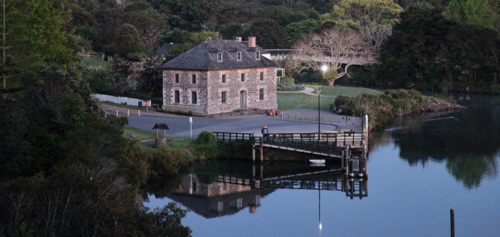Matariki the star attraction at Kerikeri Mission Station
Kerikeri Mission Station is celebrating Matariki with events for an entire month! (19 June - 11 July)
Children visiting Kemp House and the Stone Store at Kororipo Heritage Park in Kerikeri will have the opportunity to colour and decorate their favourite Matariki star, which will then be displayed under the eaves of the Honey House Café and the Kemp House verandah.
Matariki marks the beginning of the Māori New Year, and traditionally came at a time when the storehouses were full after crops had been harvested, and seafood and birds gathered. The cold winter season made Matariki the perfect opportunity for people to come together with kai, singing and dancing. It was also a time when children and young people were taught about their connection to their natural environment – the forests, the sea and the soil.

Matariki, the Māori New Year, is marked by the Pleaides star cluster
“We’ll be inviting tamariki to choose a star from the nine stars in the Matariki cluster to colour in and we’ll then hang them under the eaves of the Kemp House verandah and the Honey House Café,” says Kerikeri Mission Station Property Lead Liz Bigwood. “Each star will come with the explanation of its name in Māori, what it represents and an explanation of the significance of the Matariki season itself. We’ll supply the crayons and the stars throughout the Matariki period – and our tamariki visitors will provide the creative input.”
The aspect of Matariki that involves the passing on of knowledge about things like cultivation to children will also be celebrated as part of the Matariki activities at the Kerikeri Mission Station, which is recognised as a Tohu Whenua - one of our most treasured heritage places.

The Stone Store at Kororipo Heritage Park in Kerikeri. Image: Claudia Babirat
“Our young visitors will be given a pumpkin seed planted in a pulp paper container with some potting mix to look after,” says Liz. “They’ll then be encouraged to take these with them and plant them at home.”
Many Matariki celebrations follow these same customs today with the addition of flying kites, which are meant to represent the fluttering of stars. Matariki is both the name of the Pleiades star cluster and the season of its first rising – which usually takes place in late June or early July.
In addition to engaging with youngsters, the Honey House will feature several delicious additions to its menu over the Matiriki season including star-shaped biscuits, Peruperu and watercress soup served with kawakawa infused oil and homemade damper; and George Clarke Junior’s Smoked Fish Pie topped with kumara mash.

Kemp House and the Honey House Cafe at Kororipo Heritage Park in Kerikeri. Image: Claudia Babirat
Inspired by George Clarke’s recollections of fishing as a child growing up at the Kerikeri Mission Station along with his friend Hōne Heke, who started his schooling at the Kerikeri mission, the pie looks back to his boyhood when he lived in what is now known as Kemp House between 1824 and 1832. “During that time George Jnr and Hōne Heke fished, swam and climbed trees together roaming around the wider settlement and beyond,” says Liz. “George Junior wrote of the time that ‘fishing for sprats and eels seemed the noblest occupation of humanity. I had to do most of my fishing with bent pins as a real fish hook was a rare treasure, and made me as happy as a King’.”
Like all the missionary children, George Clark Jr was fluent in te reo, and felt comfortable in Te Ao Māori (the Māori world) according to Liz. “His recollections are tinged with fondness, rather than fear, and it is this that distinguishes him from his parents and other missionary commentators of the time, just as it distinguished all the missionary children,” she says. “They grew up with the sights and sounds of Māori culture, speaking the language, and playing with their Māori friends.”
The celebration of all things Matariki at the Kerikeri Mission Station begins on June 19 and runs through to July 11.



